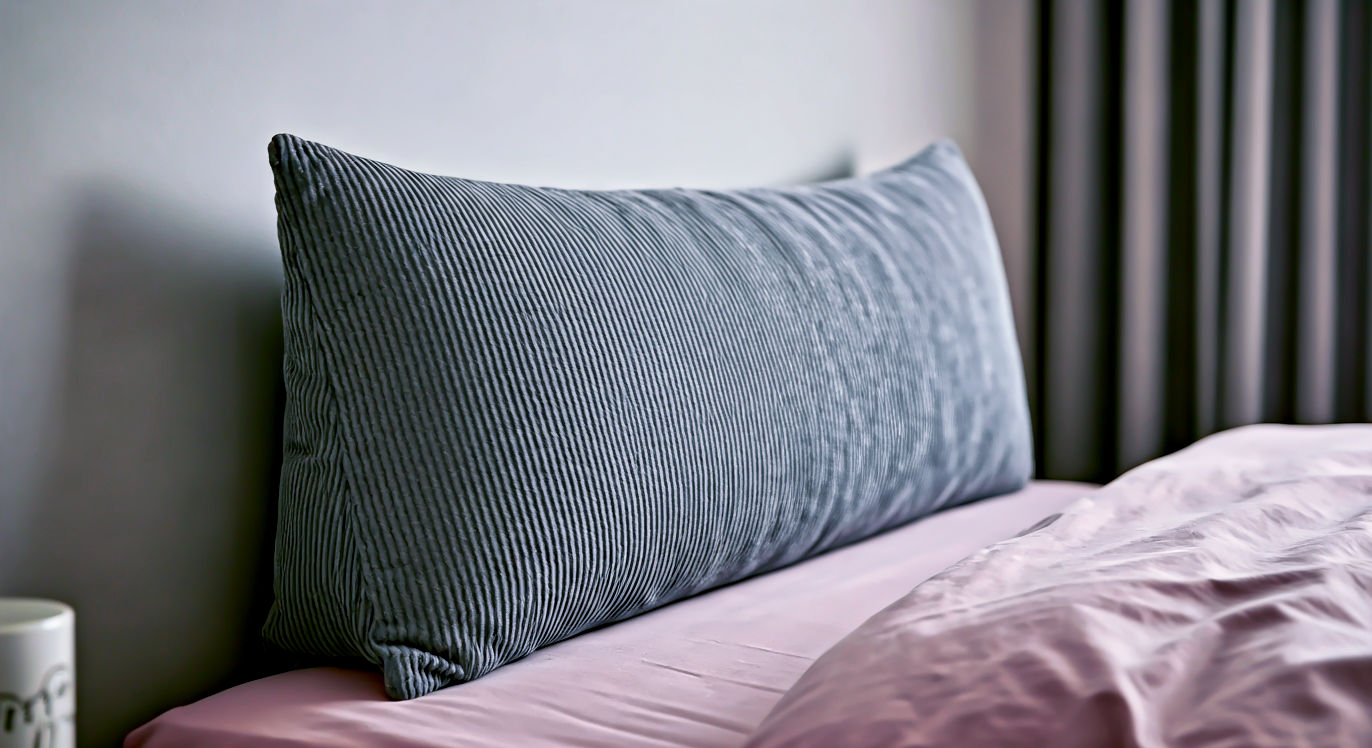The Guide to Backrest Pillows: Your Partner in Comfort and Support
Everything you need to know about backrest pillows. From their history to the science of support, find out how to choose the best one for you.

This post may contain affiliate links. If you make a purchase through these links, we may earn a commission at no additional cost to you.
We’ve all been there. You’re settled in bed with a good book, propped up against a clumsy stack of pillows that keep slipping. Or maybe you’re trying to work from the sofa, and a dull ache is starting to creep into your lower back. It’s a classic British problem, trying to get comfy in a space that’s not quite designed for it. But what if there was a simple solution?
Enter the backrest pillow. You might have seen them around. They’re those sturdy, chair-shaped cushions, sometimes with little arms, that look a bit like a hug you can lean on. Often called a husband pillow, a reading pillow, or a sit-up pillow, this clever invention is more than just a cushy accessory. It’s a game-changer for anyone who loves to read, work, or just relax in bed without turning into a slouching mess.
In this guide, we’re going to explore everything there is to know about these brilliant pillows. We’ll look at how they started, why they’re so good for your back, and how to choose the perfect one for your home. Think of this as the definitive story of the humble backrest pillow—a true unsung hero of home comfort.
What Exactly Is a Backrest Pillow?
So, what makes a backrest pillow different from the standard ones you sleep on? It’s all about the design.
A Simple Idea, Cleverly Executed
At its heart, a backrest pillow is a specially shaped cushion designed to support your upper body in a seated position. Imagine a mini armchair without the legs. It has a tall, wide back section that supports your entire back, from your shoulders right down to your lower spine. Most of them also have two arms that extend forward, giving you a place to rest your elbows, hold a book, or keep your tablet steady.
This isn’t just about feeling cosy. It’s about ergonomics—the science of making things comfortable and efficient for people to use. When you’re sitting up in bed or on the floor, your spine is in a vulnerable position. Without proper support, it’s easy to slump, which puts a strain on your muscles and can lead to aches and pains. A backrest pillow provides the firm, structured support needed to keep your spine in a healthy, natural alignment.
The Difference Between a Backrest and a V-Pillow
You might be thinking, “I’ve seen V-shaped pillows. Aren’t they the same thing?” It’s a fair question, as they both aim to provide support. However, they’re designed for different jobs.
A V-pillow is great for side sleepers or for providing general support around the neck and shoulders. It’s flexible and moulds around you. A backrest pillow, on the other hand, is much more structured. It’s built to mimic the upright support of a chair. Its firm back and arms are specifically designed to hold your torso upright, making it far superior for activities like reading, typing, or watching telly for long periods. While a V-pillow offers gentle propping, a backrest pillow provides robust, posture-correcting support.
The Surprising History of Propping Ourselves Up
Humans have always looked for ways to get comfortable. For centuries, we used whatever was on hand—piles of straw, animal furs, or simple cushions—to prop ourselves up. But the idea of a dedicated pillow for sitting up is a more modern invention, born from our changing lifestyles.
From Victorian Lounging to Modern Multitasking
In the Victorian era, the well-to-do had fainting couches and chaise longues for reclining in style. But for most people, the bed was strictly for sleeping. Reading or socialising in bed was often seen as improper or a luxury reserved for the sick.
Things began to change in the 20th century. With the rise of central heating, bedrooms became more comfortable, and activities like reading in bed became more common. After World War II, a new wave of innovation in home goods brought all sorts of new products to the market. This is when we start to see the early ancestors of the modern backrest pillow. These early versions were often simpler, filled with foam chips or cotton, but the basic idea was the same: to make sitting up in bed a more pleasant experience.
The name “husband pillow” is thought to have come from this post-war era. The pillow was marketed as a dependable, supportive “husband” that would always be there to lean on. It’s a bit old-fashioned now, but the name has stuck around!
The Rise of the “Bed Office”
In recent years, the backrest pillow has had a massive resurgence. Why? Because our homes have changed. With the boom in remote working and the fact that many of us live in smaller spaces, our beds and sofas have become multi-purpose zones. They’re not just for sleeping or relaxing anymore; they’re also our offices, cinemas, and dining rooms.
Laptops, tablets, and smartphones mean we can work and play from anywhere. This flexibility is brilliant, but it’s not always great for our posture. Hunching over a laptop in bed is a recipe for back pain. The backrest pillow has become an essential tool for creating a comfortable and ergonomically sound workspace, wherever you choose to set up. It’s the perfect solution for the modern, multitasking home.
The Science of Support: Why Your Back Will Thank You
Using a backrest pillow isn’t just about feeling snug; it’s about looking after your physical health. Poor posture can lead to a whole host of problems, from chronic back pain to headaches and fatigue. Here’s how a good backrest pillow helps.
Promoting Healthy Spinal Alignment
When you sit, especially without support, gravity encourages your spine to curve into a “C” shape. This is called kyphosis, or slouching. This position puts a huge amount of stress on the discs and muscles in your lower back (the lumbar region).
A backrest pillow is designed to counter this. It provides firm lumbar support, filling the natural curve of your lower back and encouraging your spine to maintain its healthy “S” shape. This takes the pressure off your spinal discs and reduces muscle strain. By keeping your spine aligned, it helps prevent the micro-traumas that build up over time and lead to chronic pain.
Reducing Neck and Shoulder Strain
When you slouch, your head tends to drift forward. Your head is surprisingly heavy—about the weight of a bowling ball! For every inch your head moves forward, it adds an extra 10 pounds of pressure on your neck and shoulder muscles. It’s no wonder that hours spent looking down at a screen can leave you with a stiff, aching neck.
By supporting your upper back, a backrest pillow helps to keep your head in a neutral position, directly above your shoulders. The armrests also play a crucial role here. By supporting your arms, they take the weight off your shoulders, allowing those muscles to relax. This is especially helpful when you’re holding a heavy book or a tablet for a long time.
Beyond the Back: Other Health Benefits
The benefits of good posture go beyond just preventing aches and pains.
- Improved Breathing: When you sit up straight, your diaphragm has more room to move, allowing you to take deeper, more efficient breaths. Slouching compresses your chest cavity and can lead to shallow breathing.
- Better Digestion: Sitting upright can also help with digestion. Slouching can squash your internal organs, which can slow down digestion and contribute to issues like acid reflux. This is why a backrest pillow can be a great comfort for people who need to remain upright after eating.
- Increased Energy and Focus: Good posture can even affect your mood and energy levels. Studies have shown that sitting upright can make you feel more confident and alert. When your body is properly supported, it uses less energy holding itself up, leaving you with more energy for other things.
Choosing Your Perfect Comfort Companion: A Buyer’s Guide
Ready to find your perfect backrest pillow? With so many options out there, it can be tricky to know where to start. Here’s a breakdown of what to look for.
The Filling: What’s Inside Matters Most
The filling determines the pillow’s comfort, support, and durability. There are three main types to consider:
- Shredded Memory Foam: This is the most popular choice, and for good reason. Shredded memory foam is made up of thousands of tiny pieces of foam. This allows the pillow to be both supportive and breathable. The foam moulds to the shape of your body, providing personalised comfort, while the air pockets between the shreds prevent you from getting too hot. Many pillows with this filling also allow you to add or remove foam to customise the firmness.
- Best for: Personalised comfort and excellent support.
- Solid Memory Foam: Some pillows use a single, solid block of memory foam. This offers very firm, consistent support. However, it can feel a bit rigid for some people and may trap heat more than shredded foam.
- Best for: Those who need maximum, unwavering support.
- Polyester Fibre Fill (Poly-fill): This is a synthetic, budget-friendly option. It’s soft and lightweight, but it doesn’t offer the same level of support as memory foam. Over time, poly-fill can become compressed and lumpy, so it may need replacing sooner.
- Best for: Occasional use or those on a tight budget.
The Cover: Fabric and Functionality
The outer cover is what you’ll be leaning against, so it needs to be both comfortable and practical.
- Velour or Plush Fabric: These are incredibly soft and cosy, making them perfect for relaxing. They feel lovely against the skin and add a touch of luxury.
- Corduroy: A classic choice that is both durable and comfortable. It has a nice texture and is very hard-wearing, making it great for everyday use.
- Cotton or Linen Blends: These are breathable and natural choices, ideal for people who tend to get warm. They offer a cooler feel than plush fabrics.
Whatever fabric you choose, make sure the cover is removable and machine-washable. Spills happen, especially when you’re enjoying a cup of tea in bed! A washable cover makes it easy to keep your pillow fresh and clean.
Size and Shape: One Size Doesn’t Fit All
Backrest pillows come in various sizes, from small ones for children to extra-large ones that can accommodate two people.
- Standard Size: This is perfect for most adults and teenagers for individual use.
- Extra-Large/Oversized: These offer more generous support, with a taller back and wider arms. They’re a great choice for larger individuals or for anyone who wants a really luxurious, all-encompassing feel.
- Consider Your Height: If you’re taller, look for a pillow with a higher back to ensure it supports your entire spine, including your neck and shoulders. Some pillows even come with a detachable neck roll for extra support.
Extra Features: The Little Things That Make a Big Difference
Many modern backrest pillows come with handy extra features.
- Pockets: Side pockets are incredibly useful for keeping your phone, remote control, or glasses within easy reach. No more fumbling around in the bedsheets!
- Carrying Handle: A sturdy handle at the top of the pillow makes it easy to move from room to room.
- Detachable Neck Pillow: For those who suffer from neck pain, an adjustable or detachable neck pillow (or cervical bolster) can provide targeted support and comfort.
- Lumbar Support Cushion: Some high-end models include an extra, smaller cushion that can be positioned to give your lower back even more support.
More Than Just a Reading Pillow: Creative Ways to Use It
The beauty of the backrest pillow is its versatility. It’s not just for reading in bed. Here are some other ways it can make your life more comfortable.
The Ultimate Gaming Throne
Gamers often spend hours sitting in one position, which can be tough on the back. A backrest pillow can turn any spot on the floor or sofa into a comfortable and supportive gaming chair. The armrests are perfect for supporting elbows during long sessions, reducing shoulder strain.
Your Work-From-Home Hero
As we’ve discussed, a backrest pillow is a must-have for anyone who works from their bed or sofa. It helps create an instant ergonomic setup, promoting good posture and helping you stay focused and comfortable throughout the workday.
A Comforting Companion During Illness or Recovery
For anyone confined to bed due to illness or recovering from surgery, a backrest pillow is a true blessing. It allows them to sit up comfortably to eat, watch TV, or chat with visitors, which can make a huge difference to their morale and physical comfort. It’s particularly useful for new mothers, providing excellent back support during late-night feeds.
Creating a Cosy Corner Anywhere
A backrest pillow can instantly create a comfy, quiet corner for a child to read or do their homework. Pop one in a corner of their bedroom with a few cushions and a blanket, and you have an instant cosy nook. They’re also brilliant for university students living in halls, transforming a standard dorm bed into a comfy study and socialising spot.
Support for Hobbies
Whether you’re knitting, drawing, or playing a musical instrument, many hobbies require you to sit for long periods. A backrest pillow can provide the support you need to enjoy your hobbies for longer, without discomfort.
Caring for Your Backrest Pillow
To get the most out of your pillow, it needs a little bit of TLC.
Keeping It Clean
- Wash the Cover Regularly: As mentioned, a machine-washable cover is essential. Follow the care instructions on the label, but most can be washed on a gentle cycle and either air-dried or tumble-dried on low.
- Spot-Clean the Inner Pillow: If you spill something on the inner pillow, try to spot-clean it with a damp cloth and a mild detergent. Avoid soaking the filling, especially memory foam, as it can be difficult to dry and may damage the material.
- Airing It Out: Every now and then, it’s a good idea to air out your pillow, especially if it’s memory foam. You can leave it in a well-ventilated room or outside on a dry, breezy day (but keep it out of direct sunlight) to help keep it fresh.
Fluffing and Reshaping
If your pillow has a shredded foam filling, it may need fluffing up from time to time to restore its shape and loft. You can do this by simply shaking it vigorously or by putting it in the tumble dryer on a no-heat or low-heat setting for 20 minutes with a couple of tennis balls (check the manufacturer’s instructions first).
The Future of Comfort: What’s Next?
The humble backrest pillow continues to evolve. Designers are always looking for new ways to improve comfort and support. We’re starting to see pillows with integrated features like heating elements for soothing sore muscles, or built-in massagers.
There’s also a growing focus on sustainable materials, with more pillows being made from organic cotton, bamboo fabrics, and plant-based foams. As our understanding of ergonomics and wellness grows, we can expect to see even more innovative designs that are tailored to our specific needs.
The Final Verdict: An Essential for Modern Living
The backrest pillow is so much more than just a big cushion. It’s a simple, effective, and affordable tool for improving your posture, reducing pain, and enhancing your everyday comfort. In a world where our homes have become our offices, cinemas, and sanctuaries, this versatile pillow has become an indispensable part of modern living.
Whether you’re an avid reader, a dedicated gamer, a remote worker, or simply someone who enjoys a bit of comfort, a good backrest pillow is a small investment that pays huge dividends in your health and wellbeing. It’s a reminder that sometimes, the simplest ideas are the best. It’s a supportive hug, a trusty companion, and a quiet champion of comfort, ready to make every day a little bit cosier.
Further Reading
For those interested in exploring the topics of ergonomics, posture, and home comfort further, here are some highly respected resources:
- The Chartered Institute of Ergonomics and Human Factors (CIEHF): The UK’s professional body for ergonomists, offering resources on workplace and home ergonomics.
- The National Health Service (NHS) – Live Well: Provides practical advice on common posture problems and exercises to prevent back pain.
- The Sleep Charity: A leading UK charity offering evidence-based advice on creating a comfortable and healthy sleep environment.






